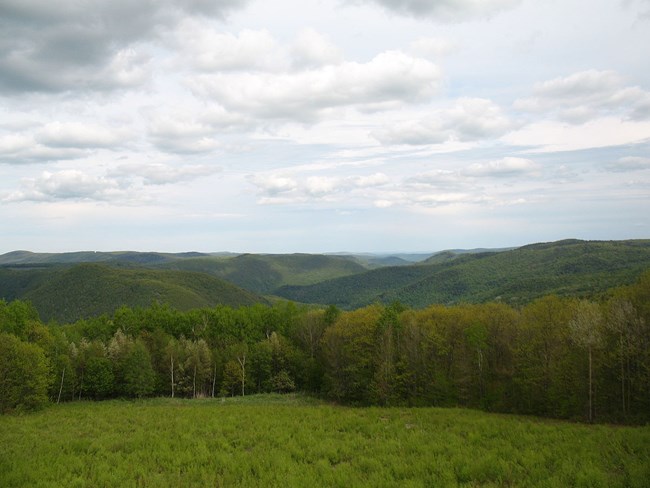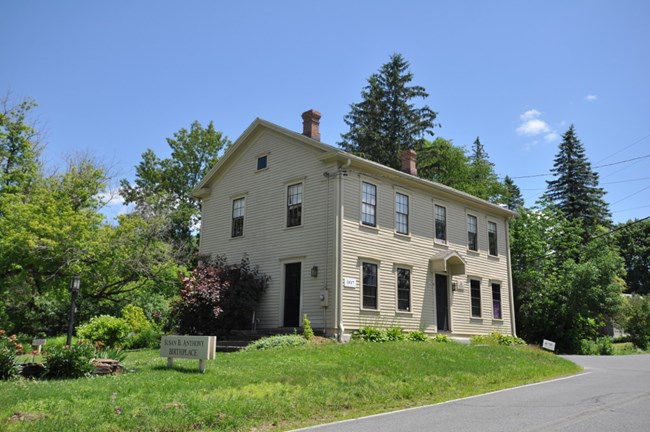Part of a series of articles titled Creative Teaching with Historic Places: Selections from CRM Vol 23 no 8 (2000).
Article
Solving Local History's Mysteries: Researching Buildings for Fifth-Grade Teaching

https://en.wikipedia.org/wiki/File:The_Berkshires_near_North_Adams_MA.jpg
Published by the National Park Service, Cultural Resources
by Rosalyn S. Cohen
When I was “volunteered” to participate in the Jacob’s Ladder Heritage Education Project, I had no idea what would be involved until the contract arrived. But at the first meeting I realized that this was going to be no ordinary curriculum-writing assignment. What had my school system gotten me into?
My husband and I have lived in Berkshire County in western Massachusetts for nearly 30 years, mostly in Lee, a community of about 7,000. I have been a teacher here since 1987, in the same school that my children attended. Lee Central School houses about 600 children in pre-K through eighth grade; the high school serves about 400 students. Rather than join a regional district, we have remained local. Three fifth-grade teachers share a semi-departmentalized arrangement. My primary job is to teach English, but I also teach social studies to my 16-student homeroom.
Our curriculum, driven by the Massachusetts Curriculum Frameworks and Massachusetts Curriculum Frameworks and Massachusetts Comprehensive Assessment System (MCAS), examines US geography and history before 1810. I believe in building upon and tying the curriculum into the children’s personal experiences. Whenever possible, I bring my own experiences and travels into the classroom as well. I have a passion for early American history and love teaching it, but have never studied local history, so this project immediately intrigued me. As a traveler who concentrates on historic sites, I was aware of the National Park Service and the National Trust for Historic Preservation, but unfamiliar with the Teaching with Historic Places (TwHP) program; however, daunting as this project initially appeared, I quickly saw the opportunity to make history come alive for young students. What could be more meaningful than to teach local history through buildings that the children see daily?
Right away, the project was an eye-opener. I was aware, for example, of some colonial-era buildings in town, but I had no idea how many. My understanding of Lee history was that most of the important events and buildings dated from about 1820. I was about to be proven very wrong!
In the beginning, though, it looked like this undertaking would never get off the ground. Most surviving public buildings in Lee date from the mid-19th century, and a few 18th-century buildings were within walking distance of our school, a critical point since just one bus trip to even a few miles away required permission slips, chaperones, and several hundred dollars. The oldest building near our school wasn’t old enough; another building was too far away to be practical. Besides, we are building a new elementary school in another part of town, so I was looking for someplace walkable from where? Documentary research wasn’t any easier. The 1878 town history turned out to be one-stop shopping, but the library’s only copy couldn’t leave the building. Meanwhile, a 19th century town hall fire and 20th century renovations meant the loss of most early records.
But things soon began to look up. A retired teacher, Mary Morrissey, mentioned an inventory of old buildings. A sympathetic clerk in the Assessor’s office told me about Charlotte Davis, the acknowledged expert on local history and a walking encyclopedia (or hard drive), who provided a thumbnail sketch of the town’s whole story, well into the 20th century. I was fascinated but tried to stay focused on the period in question. She seemed to know everything, and I was writing furiously, trying to get it all down. I even learned that one fifth-grade student descended from one of the town’s first families. Even he was not aware of that and thought it was pretty neat.
Back on the phone to Mary, who helped me identify buildings near the new school site that looked promising. Progress at last! At the library, I found the historic site inventory in the librarian’s office. Not only that, but some of the books brought up from the basement archives on my initial visit now sat on the reference shelf. The librarians, fascinated with my project, refused to charge for photocopies, asking only that I donate a copy of my finished product. I was finally getting somewhere!

https://en.wikipedia.org/wiki/File:AdamsMA_SBAnthonyBirthplace.jpg
I then visited the Berkshire County Registry of Deeds and found wonderful maps, Lee’s petition and charter, and original deeds, which wove a fascinating story of land acquisition and finance during the time of the Revolution. It was like working in the National Archives! The Berkshire Athenaeum’s local history room yielded more information. I then gave the Town Hall another try and this time struck gold, locating early Selectmen’s minutes along with invaluable vital records. Shortly thereafter, a copy of the 1878 history surfaced right in my school’s library. However, the best was yet to come.
A chance comment in the teachers’ lounge led to a break that can only be described as miraculous. Henry Bassett Holt, a Bassett descendant, resided in Lee. I nervously called, worrying that he would be annoyed at the intrusion. Quite the contrary; the Holts were excited about my project and promptly invited me over. There began a most amazing, almost surreal, historical journey. As I entered the house, I saw portraits of the very people I was researching. The Holts opened boxes of Dimmick/Bassett memorabilia and said I was welcome to use whatever I wanted. I will always be infinitely grateful for their invaluable assistance and encouragement.
I linked these unique and rare primary source materials – documents, portraits, and houses – to the town’s history, in order to give students a view of the lives Lee youngsters might have experienced at this time. What kind of families lived in these homes, and what stories can be told by them? I solicited suggestions from my students, and they had terrific ideas that helped me develop my lessons. My students were incredibly supportive and wanted to hear it all. They were delighted to “pilot” some of the lessons as I drafted them. Their favorite ploy was to get me sidetracked from regular lessons with questions about my project!
At some point, I hope to develop a year-long curriculum, using the TwHP model, that supports the Massachusetts Frameworks. This project has personalized both the town’s history and the teaching of it, giving it an aura of excitement that cannot be gleaned from textbooks. The TwHP curriculum format allows us to relate broad topics to our own experiences and situations. Additionally, I hope that this will encourage other districts to develop similar local history curricula.
Lee’s buildings have many stories to tell, but to get it all into the hands and minds of children remains challenging. This project has gained a life of its own, and there is much more still out there. I have a much greater appreciation for Lee’s unique character and its determination to survive as a rural community. It’s hard to drive past buildings in town without putting dates on them and thinking about their roles in history.
Coincidentally, my college’s motto was “Who dares to teach must never cease to learn.” I am definitely not ceasing to learn!
At the time of publication, Rosalyn S. Cohen taught fifth grade at Lee Central School, Lee, Massachusetts.
Last updated: July 2, 2019
